Back in 2019, Oliver Schulz explained the work made by RISE on the visual effects for Captain Marvel. He then worked on Reminiscence and Eternals.
How did you and RISE get involved on this show?
There were already some early talks between Overall Supervisor Angus Bickerton and Executive Producer Florian Gellinger as well as Katrin Arndt a Senior VFX Producer, who already worked with Angus on a previous Kingsman movie. When The King’s Man got into production they felt RISE was a good fit for those sequences that featured a lot of set extensions, lots of compositing work and digital body augmentations. Originally the bulk of the work was a sequence that leaned heavily into an area where we hadn’t had a lot of experience doing it and performed a lot of RnD, which got me pretty excited. The tests turned out great and the acting and edit of that sequence was amazing, but it was sadly cut from the final movie before we could start finishing it up.
What was your feeling to enter into the Kingsman universe?
I had seen the first installment of the series and was therefore very much looking forward to work on that franchise. As this movie wasn’t the typical Kingsman movie and played in front of the historical WW1 scenario honestly got me even more excited to work on that.
How was the collaboration with Director Matthew Vaughn and Production VFX Supervisor Angus Bickerton?
We worked exclusively with Angus with whom we had weekly or bi-weekly cineSyncs to discuss our work. He would than present this to the Director for approval. The collaboration was great to say the least, Angus is a very open minded, well versed, experienced and on top of that very funny guy that made the working relationship with him a very enjoyable ride. All of the VFX requirements were very well thought out and planned beforehand, mostly already visualized by Angus himself or his team. That made working with this Production very straight forward.
On the other hand was he very collaborative and open to our suggestions when we were proposing things we thought might work well in a given context. All in all it was a very lovely bouncing off of ideas between us and him. I’m very much looking forward working with him again.
What were their expectations and approach about the visual effects?
Overall the main goal for the VFX was first and foremost to feel real. Of course it had to fit the style of lighting that had been done on set which sometimes is a trade of between realism and stylization. In case of set extensions it’s always to bring local lighting into a context of global lighting. For something like body replacements for the crippled Kaiser hands, it´s again a tradeoff between realistic and going a bit over the top to get the story point across. Generally they always tried to shoot something in camera to give us as base to work off of which is invaluable to reach a photographic result faster. We would also incorporate any photographic elements we could use into full cg shots to make them feel real.
How did you organize the work with your VFX Producer?
Senior Visual Effects Producer Katrin Arndt and I have worked on several shows by now. She has been in the business for a long time and clearly knows what she is doing. On top of that she worked with Angus before which was great as well because she already knew how he likes to work.
As we shared this show with our Munich office doing a big bulk of work, we had Marlene Nehls running the daily business over there keeping everything under control. We tried to communicate as much as we could on a daily basis to ensure everyone was up to date with any change of plans or client requests. Because Berlin was the lead facility for this project and also the client facing site, Katrin would oversee all the work done at RISE to make sure everything was going according to schedule and all the resource would be in place. Having her backing me up on all of this really gave me the freedom to focus on everything creatively. This show couldn’t have been done without her!
How was split the work between the RISE offices?
As often we tried to split the work by sequences, with CG Supervisor Sebastian Lauer and Comp Supervisor Julia Strack running the Munich team. Berlin was overseen by CG Supervisor Bernhard Esperester and Comp Supervisor Rayk Schroeder. Like often this splitting doesn’t completely go to plan because of omitted or growing sequences, so we ended up sharing lots of setups and assets to carry out similar work in both locations.
What are the sequences made by RISE?
From what ended up in the final cut, RISE Munich took on most of the Rasputin fight sequence happening in Yusupovs Palace as well as the establishing shots for it. As this sequence grew quite substantially during the edit, the beginning of that sequence with Oxfords leg wound and the poisoned cake and some shots towards the end where handled in Berlin.
RISE Berlin did all the young and old Kaiser`s hand replacements, the train ride establishing shots going from and to Russia, the night interior train ride sequence and the crowd shots inside the Tsar Palace.
We discover massive environments during a train ride. How did you create this massive environment?
This sequences was overseen and setup mostly by CG Sup Bernhard Esperester. We had a plate based establishing shot at the beginning of the sequence where we inserted the steam train into a snowy northern landscape with pine trees surrounded by bigger mountains, just augmenting the background and sky to fit the mood of the sequence and time of day.
For the environment base we utilized Houdini´s terrain tools to replicate the look of the mountains and snowy hills seen in the establishing shot. We also build lots of little assets like wooden power poles, pine trees, bushes, snow piles, grass clumps and distant houses to scatter around this environment to give some life. Using the edit we assembled a previs version of the whole train ride environment in Maya that spanned some kilometers of environment in total. Blocking in the big shapes to create interesting compositions on a per shot basis and trying to sell movement of the train through the environment layout itself or through speedup in animation. After everything was in place and we got approval for the environment layout itself we pulled all of this into Houdini and got into the details of making it look real. We scattered all of our little assets over our base geometry making sure to get lots of parallax, avoiding repeating patterns and use basically all tricks of the trade to make it look convincing. Adding to this were FX snowflakes and bits of steam passing by.
Another important part to make this sequence work fell into the realm of the comp department. Lots of credits go to Sequence Lead Falk Hoffmann that spearheaded the comp crew for this Sequence. As the interior of the Kingsman carriage was shot on a bluescreen stage and no hint of the environment was present on set, it´s always difficult for these kind of shots to balance the exposure for the interior and the exterior convincingly while keeping the exterior readable and on the other hand matching the lighting that was done on set. There was a lot of partial grading of the plate and the CG involved to make that work. On top of that Comp applied separate 2d transformations for camera and carriage shaking to the different layers to make it look as this was shot on a moving train.
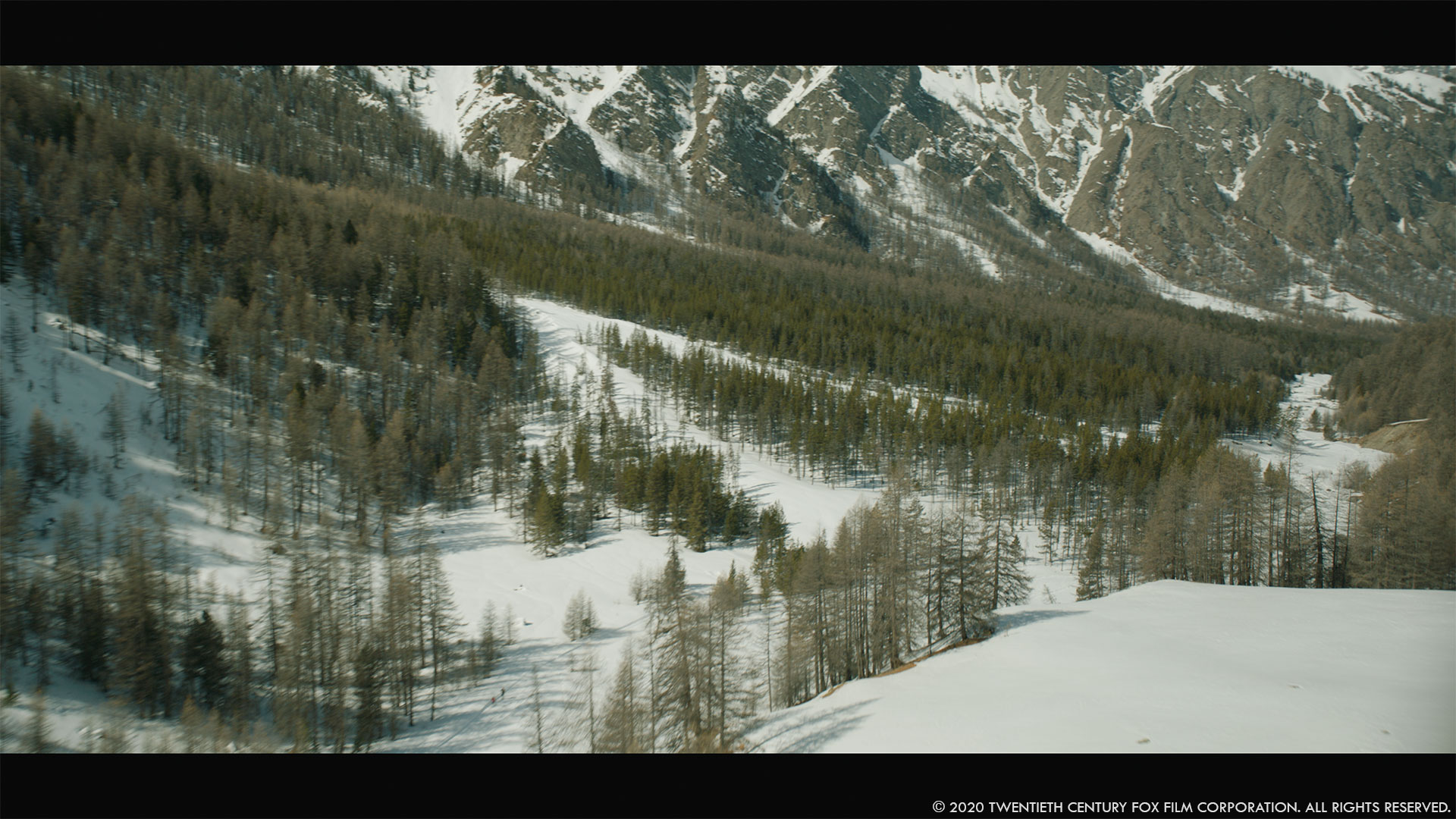
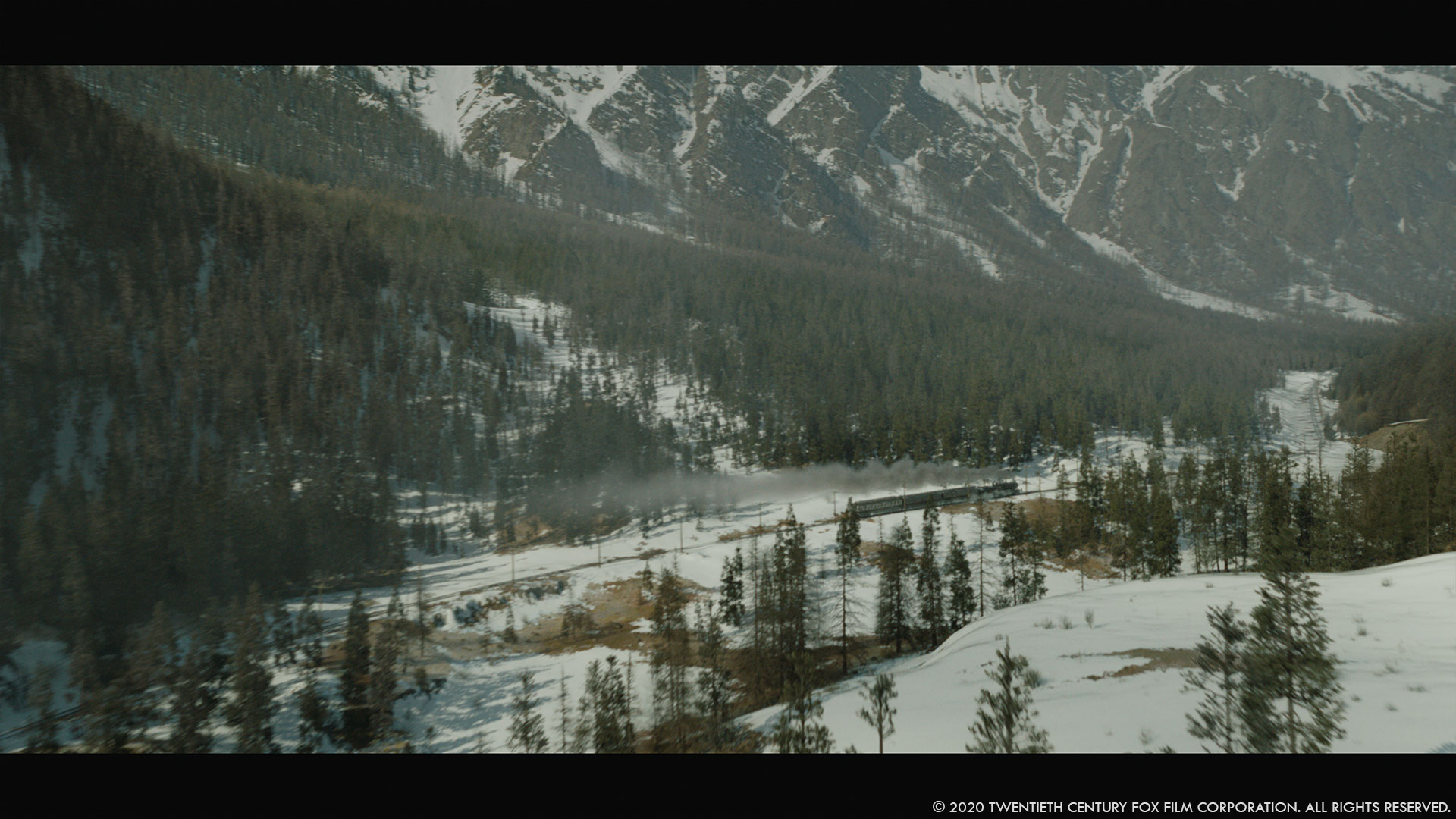
Can you elaborates about the train creation?
The train was based on real world references for the steam locomotive and the carriages that was provided by Angus and his team. The Kingsman carriage of course existed as a full interior set, so we needed to incorporate this into our build for this very compartment. As this train was never seen in close up the asset build wasn’t too extensive. It did take a few rounds in lookdev and texturing though to make it feel real.
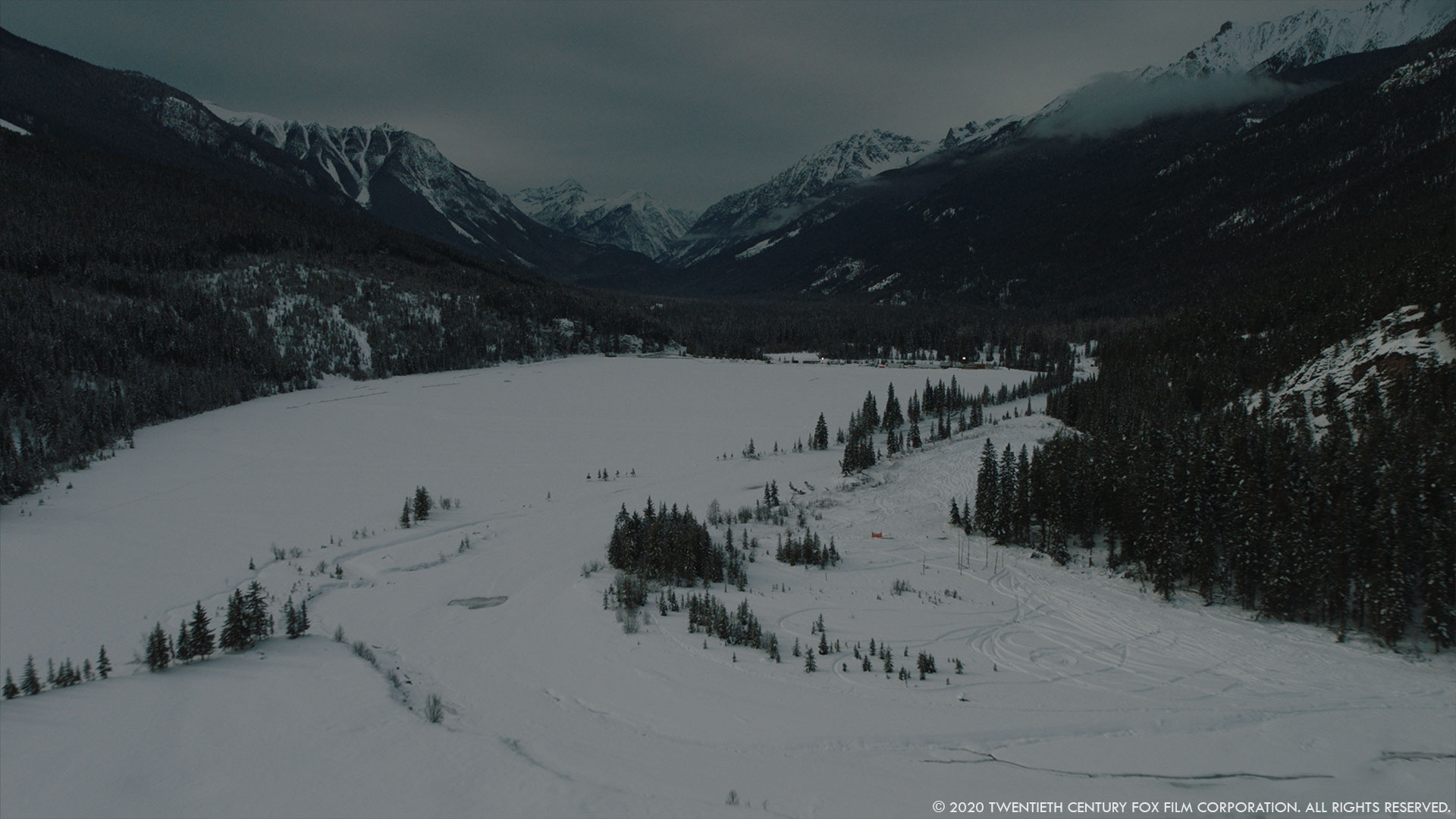
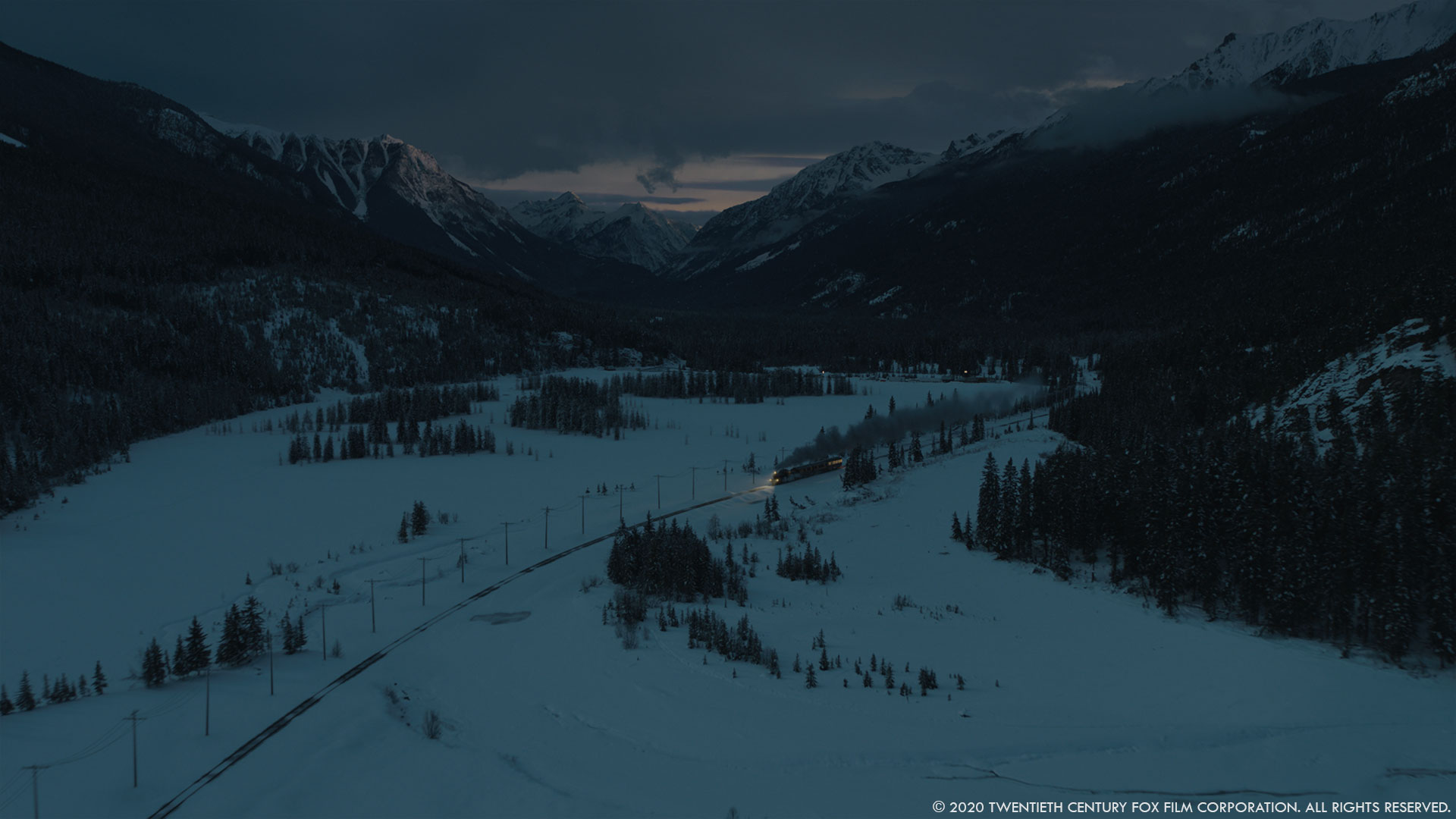
Did you use procedural tools for the environment?
We used a lot of our in-house scattering tools inside Houdini. Mountain generation was partly procedural but needed to follow specific needs for framing though, so a fair bit of art direction here. There were some procedural tools in place for something like connecting cables between power poles if I remember correctly.
Another beautiful environment is the Czar palace. What kind of references and influences did you receive for it?
For the palace we received some 2D concepts from production as well as some previs shots. These previs shots were already on such a good level that they served as a very good base for lighting, mood and such things as the density of falling snow. Then we started doing our own research for buildings of the same architectural style and period in Russia. We ingested these influences into our build and started blocking out main architectural forms, the baroque gardens with all its trees and hedges surrounding the palace and the fence with the big gate that is seen in close up in one of the establishers. For the set of the fight sequence built on a stage we tried to stay faithfully to what was build and extended that again while referencing period architecture to make sure all would make sense historically.
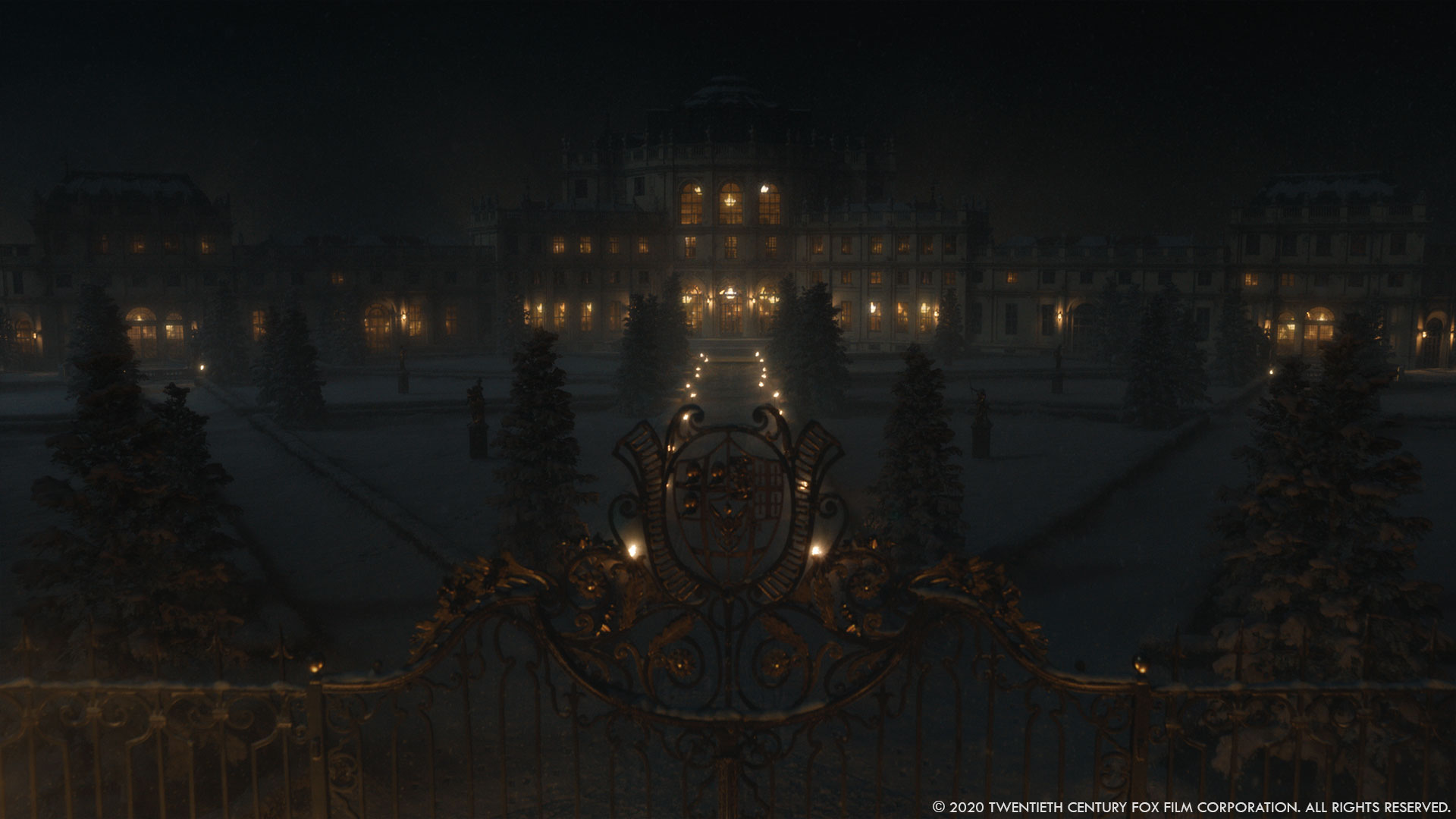
Can you explain in detail about its creation?
RISE Munich was in charge, led by Sebastian Lauer to build all these environments from scratch. All started by using the scans to incorporate the set builds from production with the previs blocking of the establishing shots, to make sure everything was clear and would be understandable geographically. We blocked out everything in a rough state and had regular chats with Angus about the layout and architecture of the whole compound, to make sure it would read from all angles, work in continuity and still create nice compositions for every shot. The interior set required detailed top offs for the ceiling with intricate paintwork to match the overall style of the very detailed set. On top of that there are mirrors on either side of the interior that needed to be partially replaced for a lot of shots because of the missing ceiling in the set build. Once everybody was happy with the overall blocking and layout of the environment we started refining all of the given elements. We scanned statues in various places in Munich to populate the garden with, covered all trees and hedges with snow, created base setups for falling snow that was needed in every shot where the exterior was visible, eventually bringing all of those parts to a very high finish depending on camera proximity.
How did you manage the lighting work?
Initially we worked on some lookdev shots to define all areas that would later be covered VFX wise. In this stage we also worked out lighting directions and how those should feel color temperature wise. For the exterior we build on top of what the DOP had done on set and contrasted the cold lighting with warm firelight from torches sprinkled through the garden. On top of that the whole Sequence was graded in comp to be consistent in itself and to adjust exterior and interior temperature to reach the desired complementary look. However despite all of the prepping done beforehand there was still an amount of adjustment needed for specific shots to make them work when set lighting was changed for certain angles.
For the exterior establishing shot, we did do a longer experimental phase on how to light the palace to guide your eye towards it and to be esthetically pleasing while still being photoreal. We experimented with an approach of lighting it with a digital wendy light, like you would do it on location but settled in the end in favor of a more classic directional lighting by a stronger moonlight source.
Can you tell us more about the crowd shots inside the palace?
The crowd shots inside the palace were done with filmed elements on location. So basically those where pretty much straight forward but still required a lot of work in roto and tracking with some extensive color correction to make it look seamlessly integrated.
Let’s talk about the impressive fight sequence with Rasputin. How did you enhance it?
This sequence was indeed a beast on so many levels. Lots of credits need to go to the 2D Supervisors Rayk Schroeder and Julia Strack for pulling this off as well as Line Producer Luigi Pisciotta who was my second brain. Most shots needed the exterior extensions, which was pretty streamlined in most cases. Much more tricky were the mirror extensions that needed to be done on lots of shots. Here lighting provided renderings of the whole interior reflecting in those mirrors, the tricky part was really to integrate those renders into the plate mirrors that are far from being perfect straight reflective surfaces. In a lot of cases this required tedious warping and selective color corrections to make that work.
The next big thing were face replacements that were needed in two cases. First if there was a stuntman performing the really artistic fighting style of Rasputin. Second if we needed to combine performances from different takes. The really nice thing was that the production shot all of the stunt performances as a second pass with the actors, not as fast as the stunt guys were going but still the same movements. Even if they weren’t usable all the time these proved to be an invaluable reference for the ground truth of how the face replacement need to look. 3D build a model of Rasputins face based on scans that was handed over to compositing. The Comp Department wrote a renderer inside Nuke that was able to render the geometry and textures with full skin shading, even using blend shape inputs. This tool was essential in getting this huge number of face replacements done in time, just because the artists could see it integrated in comp and could make realtime adjustments in the comp script. The other cases where performances were combined or the movement in the plate wasn’t as drastic, we used the plates shot on location to do the faces. Sometimes there are Face replacements that are close up fullscreen, that are so well done that I´m sure nobody will spot them in the final cut.
Other type of effects in this sequence were completely digital wounds on Oxford’s leg with close up interaction, extensions of swords, bullet wounds, stabbing wounds, digital blood, glowing pokers, floating ice enhancements, adding frozen windows, full CG backgrounds, adding CG cuts to cloth, stunt equipment removals, smoke, sparks, drug visions and of course vomit!
What was the main challenge with the fight scene?
I would say the complexity of certain shots together with the amount of different tasks needed to be carried out and of course the number of shots itself which grew to around 230 in the final edit. The other one was to stay consistent in color through that whole sequence, as a lot of the plates needed some fine balancing of interior and exterior lighting to cut seamlessly.
Can you elaborates about the Kaiser‘s crippled hand?
That was a fun task to do as it contained a lot of design work in modeling and lookdev to get to the point where it was believable but yet a bit over the top and easily recognizable as an inhibitory condition the other characters would be harassing the Kaiser with.
There were two versions of the hand we needed to build, one for the old and one for the young Kaiser as seen in some flashback sequences. We started by building the old Kaiser’s hand as this had to have much more exaggerated features just because of the age. It was based on scans of the actor and then taken directly into zBrush for conception, as we would see it from all angles. There were a lot of different versions and conditions we explored that still needed to work with all actions that the Kaiser was supposed to perform with it. Sadly there weren’t a lot of historical references for it because the German Kaiser tried to hide that condition as much as possible. That in return gave us a bit more creative freedom to experiment until we arrived at the final version referencing a lot of different bone and skin diseases. A fair amount of time was also spent in lookdev to define the translucency of the skin and how much veins and discoloration this might have.
Once we locked the old Kaiser’s hand we started building the young hand for the flashback sequences. We started again with the scan of the actor, this time knowing the precise direction to take it, but again still needing to convey a sense of youth. So we made most of the features less prominent and removed a lot from the skins imperfections. Initially only seen pretty small in frame, this task grew into much more once, later in schedule, a shot was added that was showing the young Kaiser picking up a toy soldier from a tabletop battlefield in close up. We spent a good amount of time finessing the texturing and even adding imperfections to fingernails and dried out skin patches to the model. As this shot was based on a plate, with the actor picking up a toy soldier, we needed to come up with a convincing animation of how he is grabbing it. Referencing the original performance we enhanced this in animation trying to show how hard it is for him to grab it while still being believable and photoreal. That was a tricky shot to pull off and required a lot of dedication from all departments to get right.
Most of the other shots were pretty easy compared to this one, though all of them required detailed tracking of the arm and then painting out the original hand and replacing it with the small cg one. Most of them also required detailed animation because there were a lot of actions required like fighting or writing.
Which shot or sequence was the most challenging?
Every sequence had its own set of challenges, but I would say the Rasputin fight sequence because of the variety and complexity of tasks overall, while being carried out across two sites. I think the second might be young Kaiser’s close up hand because doing hands still is not easy.
Is there something specific that gives you some really short nights?
I would say staying on top of things for the fight sequence was tough at times especially if complex color continuity comes into play. Luckily I was sharing duties at some point with Markus Degen, our CCO, who is just a wizard when it comes to color science and grading. He would later take over for me finishing up lots of shots when I needed to leave the show for a while because my daughter was born.
What is your favorite shot or sequence?
Having had the chance just recently to see our work on the big screen, I have to say everything regarding Rasputin and the fight sequence. The acting in the beginning with the poisoned cake and the leg wound is just hilarious. But the tiny hand is great as well.
What is your best memory on this show?
The cineSyncs with our team and Angus were often times so funny that I will remember that for a long time to come. But I guess nothing beats seeing your little kid for the first time…
How long have you worked on this show?
All in all I think around a year from start of RnD and asset build to finishing last shot.
What’s the VFX shots count?
That should be around 330 that ended up in the final cut. Some more that didn’t make it though!
What was the size of your team?
Around 95 people including Production and Support.
What is your next project?
As we did most of this show in 2019, I already finished on Fantastic Beasts 3. What’s up next I can’t talk about just yet.
A big thanks for your time.
WANT TO KNOW MORE?
RISE: Dedicated page about The King’s Man on RISE website.
© Vincent Frei – The Art of VFX – 2022





